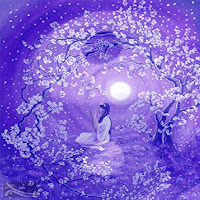Los practicantes deben tener en claro los conceptos, funciones y
efectos básicos de los "tres centros" del cuerpo, es decir, la línea
central del cuerpo, el centro de gravedad y el eje central.
La línea central del cuerpo, desde la frente (Dan Tian superior),
la nariz, el centro del pecho (Dan Zhong) hasta el perineo, actúa como una
línea de simetría que distingue entre el lado izquierdo y el lado derecho del
cuerpo.
Durante la práctica, las manos son como dos puertas, cada una a
cargo de un lado del cuerpo y no pueden cruzar la línea media.
Tan pronto como la muñeca cruza la línea media, el antebrazo
pierde su punto de apoyo y la mano pierde su fuerza.
Esta línea puede no ser muy importante para los practicantes
ocasionales, pero tiene una gran importancia en la habilidad de lucha.
El dicho a menudo "custodiar el centro" se refiere a
esta línea media defensiva.
El centro de gravedad se mantiene a través de la alineación del
Bai Hui (en la parte superior de la cabeza) y el Yong Quan (en la parte
inferior de los pies). La alineación es más obvia vista desde el lado, desde el
Bai Hui, la oreja, el hombro, la pierna hacia el Yong Quan.
Mantenga el centro de gravedad para una buena postura y
estabilidad.
La desalineación suele deberse a la incapacidad de aflojar y
activar el kua, lo que empuja las rodillas hacia delante y hacia afuera.
El eje central es la línea que une a Bai Hui con Hui Yin, y es el
eje vertical del cuerpo.
La parte superior del cuerpo gira hacia la izquierda o hacia la
derecha con la ayuda de la rotación de kua a través del eje vertical,
impulsando el movimiento de ambas manos.
El eje vertical debe mantenerse recto, posible gracias a los
requisitos fundamentales con los que la mayoría de los practicantes están
familiarizados: relajar el cuello y mantener la cabeza en alto; afloje los
hombros y hunda los codos; contener el cofre y asentar la espalda; Afloje el
kua y redondee la entrepierna.
A menudo hay confusiones entre el eje central y el centro de
gravedad. Si el eje central toma la función del centro de gravedad, el cuerpo
se convertirá en un palo en lugar de un resorte.
La columna vertebral tampoco debe confundirse con el eje central.
'Practitioners
should be clear about the basic concepts, functions and effects of the
“three centres” of the body, i.e., the centre line of the body, the
centre of gravity, and the central axis.
The centre line of the body, from the forehead (Upper Dan Tian), the
nose, centre of the chest (Dan Zhong ), to the perineum, acts as a
symmetry line that distinguishes between the left and right side of the
body. During practice, the hands are like two doors, each in charge of
one side of the body and cannot cross the middle line. As soon as the
wrist crosses the midline, the forearm loses its fulcrum and the hand
loses its strength. This line may not be very important to the casual
practitioners but it has a great significance in fighting skill. The
often-said “guarding the centre” refers to this defensive middle line.
The centre of gravity is maintained through the alignment of the Bai
Hui (at the top of the head) and the Yong Quan (at the bottom of the
feet). The alignment is more obvious viewed from the side, from the Bai
Hui, the ear, shoulder, down the leg into the Yong Quan. Maintain the
centre of gravity for good posture and stability. Misalignment is
usually through the inability to loosen and activate the kua, thus
pushing the knees forwards and outwards.
The central axis is the
line linking Bai Hui to Hui Yin, and is the vertical axis of the body.
The upper body turns left or right with the help of kua rotation through
the vertical axis, driving the movement of both hands.
The
vertical axis must be kept straight, made possible by adhering to the
fundamental requirements that most practitioners are familiar with:
relax the neck and keep the head up; loosen the shoulders and sink the
elbows; contain the chest and settle the back; loosen the kua and round
the crotch.
There are often confusions between the central axis
and the centre of gravity. If the central axis takes the function of
the centre of gravity the body will become a stick rather than a spring.
The spine is also not to be mistaken as the central axis.'









